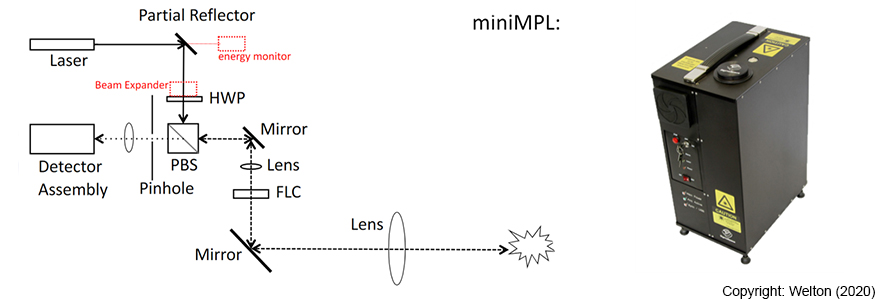Instrumentation
MINI MPL
The Micro-Pulse Lidar (MPL) is an elastic backscatter polarization lidar built by Droplet Measurement Technologies. An elastic backscatter lidar measures the laser light scattered from particles in the atmosphere back to the detector. The MPLs use eye-safe lasers operating at 532 nm and have the capability for autonomous aerosol and cloud monitoring. They provide a real-time measurement up to 30 km, allowing the determination of data products which include normalized relative backscatter and volume depolarization ratio. Other significant data products from each instrument are offered by MPLNET in 4 different datasets (NRB, Aerosol, Cloud, Planetary Boundary Layer) Utilizing these measurements, the MPL can differentiate cloud phase and aerosol type (e.g. dust, ash, smoke, and pollutants). Additionally, cloud boundary detection is possible up to 15 km. The network currently consists of 5 mini-MPLs.

Ceilometer
A ceilometer is an elastic LiDAR primarily used for cloud base height measurements and measuring total aerosol content in the atmosphere. The ceilometer located at UWO is a Lufft CHM15k-Nimbus. It operates with a vertical resolution of 5 m and a range of 15 km. The instrument utilizes an infrared laser at 1064 nm.
This ceilometer operates in conjunction with the EUMETNET (European Meteorological Network) network of wind profilers and Lidars, E-PROFILE.
CIMEL
The CIMEL sun photometer measures look directly at the Sun using a specialized tracking system. The aperture of the tracking telescope collects the light, and the ratio of light at different wavelengths can be used to measure the aerosol optical depth at multiple wavelengths, water vapour and the Angstrom Coefficient, which describes the optical thickness of aerosols based on wavelength.
Measurements from the CiMEL are sent to the NASA, AERONET. The measurements are also used to calibrate the MPL and to verify the MPLNET downloadable products.
Purple Air PM 2.5 Sensor
Purple Air is a network of real-time air quality monitoring. The sensors use PMS5003 and PMS1003 laser particle counters. Each laser pulse is used to measure the size of the particles and the mass concentrations of the particulates using light scattering to estimate particle size and abundance. The Purple Air network site displays the data across North America in multiple formats. The MPLCAN Purple Air sensors are co-located with the MPLs.

